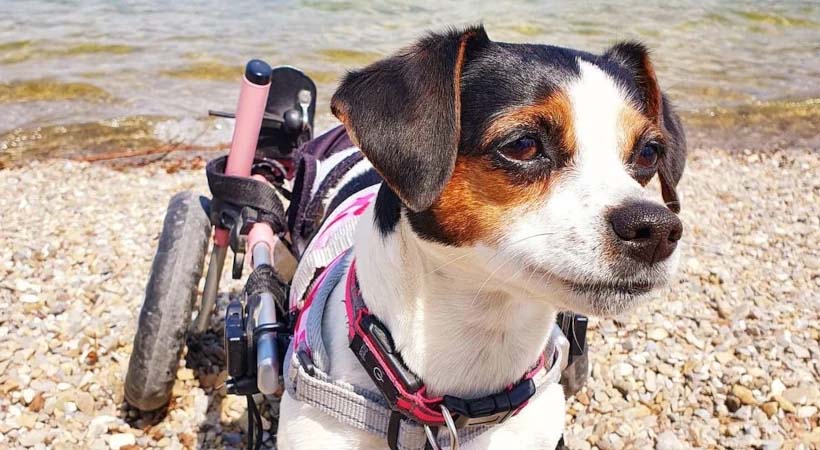Beagle Lifespan: How Long Do Beagles Live? (Life Expectancy)

6 Proven Ways to Calm Your Anxious Handicapped/Senior Dog
Anxiety is not a condition exclusive to humans, it can also be suffered by animals. Many dogs who have suffered a trauma and/or have a handicap can develop anxiety issues, and others can simply develop it as they age.
Anxiety in dogs can be treated and in many cases, completely cured. At the very least, it can be managed to the point that it is only noticeable in certain circumstances.
Let’s take a dive into what causes anxiety in dogs and what we can do to calm them.
What causes anxiety in dogs?
The most common triggers of anxiety in dogs are:
- Abandonment
- Fear of being left alone at home
- Traveling
- Loud noises
- Being around unfamiliar people, children or other pets
The originating cause of your dog’s anxiety is not always apparent, but it usually stems from a history of abuse, neglect or abandonment, or an experience of heightened vulnerability (such as experiencing a trauma or disability). It can start as older age creeps in, or begin as a pup when you leave the house for the day and they experience separation anxiety.
Anxiety in dogs can manifest in several ways, from whimpering and shivering, to barking and whining. They may even become hostile or destructive when they feel anxious. You may notice a loss of appetite or a withdrawn demeanor if it is not addressed.
The best way to help your pup with their anxiety is to determine the circumstances that trigger it.
Here are 6 proven ways to calm your anxious dog.
1. Exercise
If your dog is experiencing separation anxiety, the most obvious solution is to never leave them alone, but unfortunately, that is not always a practical option.
Anxiety usually creates an excess of nervous energy, so taking your dog out for a long walk, run or play (or all of the above!) is a great way to bond with them whilst tiring them out. Just like humans, dogs can experience relief from anxiety and stress by producing endorphins during exercise, and if you combine some physical contact and talking to them with it, it can really help them to manage their anxiety throughout the day. Of course, you will need to tailor their exercise to suit their physical abilities, but the important thing is that they use up some playful energy and feel connected to you in the process. Any way in which you can promote your dog’s well being through physical and mental health exercises is important.
2. Affection
There is probably nothing more calming and soothing to your anxious dog than to receive your affection and touch. Dogs need lots of cuddles and petting to feel truly loved and safe, and identifying early signs of increased anxiety and nipping it in the bud with a big cuddle session can do wonders.
3. Massage
Few humans would turn down a massage as a way of calming their anxieties, and it can work wonders for dogs, too! Just like us, their anxiety can cause muscle tension and giving them a massage can help to alleviate that tension. Begin at their neck and work downwards, using long, slow strokes. Try keeping one hand permanently on them while you use the other to massage them. If you do it regularly, you may even be able to identify where they are holding their stress and work those areas more thoroughly.
4. Time out
This is not designed to be a punishment, but rather an opportunity for some quiet time to calm down. Whilst anxiety itself isn’t a bad behavior, it can cause your dog to act out, and isolating them can help to calm their nerves. You could create a time-out space that has low-level lighting, quiet music playing, or even some aromatherapy.
You can also support them by providing a snug, calming place for them to rest, whether in a time-out or not. A calming dog bed can make your dog feel warm, safe and secure. You could really go to town and create a total Zen space for your pooch to unwind when they are feeling frantic or nervous, you may even make it so soothing that you end up using it for yourself!
5. Music therapy
Music therapy is a proven beneficial method for calming both humans and animals, including our beloved canine friends. Not only can music be calming in and of itself, but it can be effective at alleviating noise sensitivity as it blocks out jarring street or neighborhood noises that can often bother some dogs and cause them to feel anxious.
Research has shown that classical music seems to work well for dogs, with harp music being particularly sedative. Some suggestions to try include:
- Noah’s Harp: Surrender - by Susan Raimond
- Through A Dog’s Ear - by psychoacoustics researcher Joshua Leeds and pianist Lisa Spector
6. Calming T-shirts/coats
Similar to anxious humans experiencing relief from lying under weighted blankets, dogs can feel relief from anxiety by wearing specially designed calming coats and t-shirts. Calming clothes apply a mild, yet constant pressure to a pet's torso. It’s akin to a baby being swaddled and can be particularly relieving for dogs whose anxiety is triggered by separation, travel, noise, or fear of strangers.
If you find that nothing you try seems to be comforting or helping your beloved pooch, then a visit to the vets would be the best option. Together, you can consider the best approach moving forwards, and it may be necessary to consider a prescription medication, even for a short time, to give them a chance to recover and heal their nerves.








